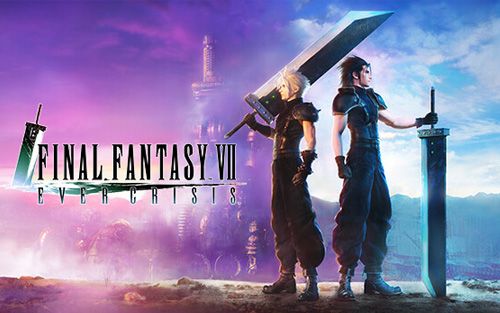Final Fantasy VII Ever Crisis
ไฟนอล แฟนตาซี 7 Ever Crisis
(As "Final Fantasy 7 Ever Crisis")
Game Introduction and Overview
- Before Crisis: Final Fantasy VII
- Final Fantasy VII: Advent Children
- Final Fantasy VII: Before Crisis
- Final Fantasy VII: Crisis Core
- Final Fantasy VII: Dirge of Cerberus
WHAT EVENTS DOES FINAL FANTASY VII: EVER CRISIS COVER?
Before Crisis: Final Fantasy VII – a Japan-exclusive mobile game that launched in 2004. Before Crisis follows the Turks – a group of covert operatives working for Shinra – six years before the events of the original Final Fantasy VII.
Crisis Core: Final Fantasy VII – a prequel set seven years prior to the events of the original FFVII that tells the story of Zack Fair. Crisis Core released on the PSP in 2007 and is one of the best-selling PSP games of all time.
The original Final Fantasy VII – the game that started it all. The original title launched in 1997 for the PlayStation 1 and follows Cloud, a misunderstood mercenary, along with a ragtag group that hope to save the world from an evil organisation called the Shinra Corporation.
Dirge of Cerberus: Final Fantasy VII – a third-person shooter that follows Vincent Valentine, a character you’ll remember if you played the original FFVII. It came out on PlayStation 2 in 2006 to mixed reviews.
Final Fantasy VII: Advent Children – a movie sequel set two years after the events of the original FFVII. The story follows Cloud, who has to stop three pale villains from resurrecting Sephiroth. It’s unclear how Advent Children will run in the Ever Crisis compilation, as it has never been a playable game in the past.
INFORMATION ABOUT THE GAMEPLAY
The gameplay will feature a traditional Turn Base system as seen in the original FFVII for the PS1. Final Fantasy VII: Ever Crisis purports to be more faithful to the original, replacing the old blocky character models with better-looking ones but keeping the feel of the PS1 version. Here are some snapshots from the game:
- In the beta, battles use a modified ATB (active time battle) system.
- You can maneuver the party's stance and choose when to initiate your ally's Limit Breaks, but you can only control one character's actions (at a time).
- Magic Points (MP) aren't part of the system. Instead, your abilities and spells all have a meter cost. You wait for the meter to charge and then tap a target to cast or perform your spell/ability.
- Players can toggle between a defense (blue) and offense (red) stance for the entire party. The defense stance decreases the amount of incoming damage the party takes; it also increases the potency of all healing spells cast when this stance is active. Meanwhile, the offense stance, as you might expect, buffs all the damage you’re dealing while in it.
- There is something special about the offense stance too. Sometimes, unique enemies and bosses go into a “countdown” phase where they begin to wind-up for a big attack. It’s indicated at the top of the screen along with a symbol and a number beneath.
- Materia makes a return, but expect it to be streamlined. Only three open slots are available, and there's no linking or creating chained effects; it's just a fancy way of choosing your magic, skills, and the associated stats.
- Co-op mode: Up to 3 different people can party up to tackle bosses.
Things we found out during the BETA Testing [Regarding gameplay]
- Story stages ramp up in difficulty. Fast.
- Every stage that contains a battle in Ever Crisis has a recommended power level number. Players aren’t required to meet it, but it’s a quick glance at how hard they can expect the stage to be.
- There are noticeably drastic difficulty spikes later on in chapter 2 of FF7. Story stages also normally lock players to a set party because of what’s going on in the narrative so sometimes it’ll only be Cloud/Barret, or Cloud/Aeirth, or Cloud/Tifa/Barret going into a given stage.
- There is a “free party” mode to allow for outside characters to complete a stage, but no completion rewards will be given for doing so.
- Going through Crisis Core a somewhat challenging prospect too because well, Zack is the only character available for that.
- Going through the story won’t be a walk in the park in Ever Crisis; it’s a game people will have to grind to overcome difficulty spikes, especially with the story-locked parties if they want to obtain all the story’s completion rewards.
- Prepare to invest in building up multiple characters and tinkering with party configurations quite a bit.
- Even though people deploy locked preset characters in story stages, they can alter their equipment and ability load-out.
INFORMATION ABOUT THE GACHA
Ever Crisis features a weapon gacha; the only things that come from a roll are 3-star, 4-star, and 5-star weapons. All weapons can eventually be upgraded to their 5-star versions by drawing duplicates of that specific weapon. Let’s say you roll a 3-star version of Tifa’s Leather Gloves. If you eventually draw her 4-star Leather Gloves, it’ll automatically upgrade its rarity and you won’t lose progress on any resources you’ve put into the 3-star version because it’s still the same Leather Gloves - just with its rarity automatically enhanced, so it’ll have better stats.
- Gacha in the game will revolve around weapons for skills and
- Costumes for some aesthetics and passives
- ALL Characters and story will be unlocked for free
- SSR weapons have a rate of 7.2%
Much of Ever Crisis’s gacha system revolves around a stamp card mileage mechanic. Every time you do a 10-roll (not a single roll) on a specific stamp banner, you will earn at least one stamp. These stamps are useful because they can give you a sizable amount of gil, weapon mats, stamina-refilling potions, and so forth. Earning 6 stamps guarantees one of the two limited 5-star gacha-only weapons featured on the banner and people can set which weapon they want to receive beforehand.
In the closed beta, one of the banners contains Cloud’s Murasame and Barret’s Microlaser. Players can choose to either receive the Murasame or Microlaser on the stamp card’s 6th stamp slot before they roll. It’s a handy feature because in my case, I rolled the Murasame before getting my 6th stamp so I set it up to receive the Microlaser instead.
Another factor to consider is that there are special costumes for characters that people can only receive once they earn 12 stamps. These costumes cannot be rolled for on their 10-roll because only weapons come out of those.
Here’s the caveat - this does not mean you need to always roll twelve 10-rolls to receive 12 stamps… well, unless you have incredibly bad luck. Remember how I said that you earn “at least” one stamp for every 10-roll you do on these stamp banners?
That’s because whenever you do a 10-roll, a nice little Chocobo animation plays that speeds past a signpost. It will inform players whether they received 1, 2, 3, or 12 stamps on that 10-roll and as you can imagine, the probability of earning more stamps decreases with the 12-stamp rate being at 1%. Yes, there is an additional layer of RNG on top of the RNG.
Important information about how 'equipments' work:
- Weapons have three important aspects to them aside from their stats: core abilities, reinforcement abilities, and support materia.
- A core ability is the unique ability assigned to that weapon.
- Reinforcement abilities provide secondary passives to a character. For instance, Cloud’s Murasame has Thunderstrike as its core ability, while Physical Strength Up and Lightning Potency Up are its reinforcement abilities.
- Each reinforcement ability is assigned a predetermined amount of points, which will become important in just a bit.
- Lastly, support materia provides further stat enhancements for the weapon as they’re unlocked but more importantly, this is where it indicates which sigil a weapon can deal bonus damage to. These can’t be changed on weapons, but it can be altered for materia.
- Both a main and sub-weapon’s core abilities are slotted into the first two slots of a character’s ATB command list in battle. Both weapons’ reinforcement abilities are equipped onto the character too, but it is heavily affected by whether it is a main or sub-weapon.
- Both a character’s main and sub-weapon are locked to weapons exclusive to that character. Meanwhile, the three sub-equipment weapons lift that restriction and they can wear any of the cast’s weapons.
- Unlike the main and sub-weapons, a character cannot use the core ability of these secondary set of weapons but like the sub weapon, their reinforcement abilities can be put on albeit half as effective, so half their point worth.
- To round out a character’s kit, the remaining three skill slots on their ATB command deck are all dictated by the three materia they equip.
- Building a party of three that have synergy with one another feels rewarding in Ever Crisis; each of the trio fills in the role and elemental gaps someone else isn’t able to provide.
Thank you for your information on evercrisis.gg
































